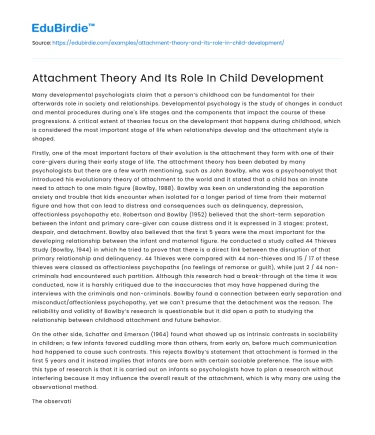Many developmental psychologists claim that a person’s childhood can be fundamental for their afterwards role in society and relationships. Developmental psychology is the study of changes in conduct and mental procedures during one's life stages and the components that impact the course of these progressions. A critical extent of theories focus on the development that happens during childhood, which is considered the most important stage of life when relationships develop and the attachment style is shaped.
Firstly, one of the most important factors of their evolution is the attachment they form with one of their care-givers during their early stage of life. The attachment theory has been debated by many psychologists but there are a few worth mentioning, such as John Bowlby, who was a psychoanalyst that introduced his evolutionary theory of attachment to the world and it stated that a child has an innate need to attach to one main figure (Bowlby, 1988). Bowlby was keen on understanding the separation anxiety and trouble that kids encounter when isolated for a longer period of time from their maternal figure and how that can lead to distress and consequences such as delinquency, depression, affectionless psychopathy etc. Robertson and Bowlby (1952) believed that the short-term separation between the infant and primary care-giver can cause distress and it is expressed in 3 stages: protest, despair, and detachment. Bowlby also believed that the first 5 years were the most important for the developing relationship between the infant and maternal figure. He conducted a study called 44 Thieves Study (Bowlby, 1944) in which he tried to prove that there is a direct link between the disruption of that primary relationship and delinquency. 44 Thieves were compared with 44 non-thieves and 15 / 17 of these thieves were classed as affectionless psychopaths (no feelings of remorse or guilt), while just 2 / 44 non-criminals had encountered such partition. Although this research had a break-through at the time it was conducted, now it is harshly critiqued due to the inaccuracies that may have happened during the interviews with the criminals and non-criminals. Bowlby found a connection between early separation and misconduct/affectionless psychopathy, yet we can't presume that the detachment was the reason. The reliability and validity of Bowlby’s research is questionable but it did open a path to studying the relationship between childhood attachment and future behavior.
Save your time!
We can take care of your essay
- Proper editing and formatting
- Free revision, title page, and bibliography
- Flexible prices and money-back guarantee
On the other side, Schaffer and Emerson (1964) found what showed up as intrinsic contrasts in sociability in children; a few infants favored cuddling more than others, from early on, before much communication had happened to cause such contrasts. This rejects Bowlby’s statement that attachment is formed in the first 5 years and it instead implies that infants are born with certain sociable preference. The issue with this type of research is that it is carried out on infants so psychologists have to plan a research without interfering because it may influence the overall result of the attachment, which is why many are using the observational method.
The observational method was used by another psychologist worth mentioning, Mary Ainsworth, who devised an assessment technique called the Strange Situation Classification (SSC) to see how attachments might vary between children. The Strange Situation Classification was conducted by Ainsworth & Wittig (1969) and was based on Ainsworth’s previous Uganda (1967). A sample of 100 middle-class American families were used to observe the different types of attachment between mothers and their infants by placing them in a small room with a one-way glass so the behavior of the infant can be observed in the absence of the mother (for a brief amount of time) without involving others. Based on their responses, Ainsworth explained that there are 3 attachment styles: secure attachment, anxious-avoidant attachment, and anxious-resistant attachment. Later on, a fourth attachment style was discovered by Main and Solomon (1986) which was named disorganized-insecure attachment. Furthermore, Ainsworth described the traits of each attachment: children with the secure attachment type tend to be slightly more optimistic than the rest and better at perceiving others perspectives as well as more trusting in them; anxious-avoidant attachment types are generally less prepared for stressful situations and less effective in managing them, they rarely can form satisfying relationships to others due to their antisocial behavior and resistance to seek assistance; anxious-resistant attachment is based on the opposite end of spectrum from anxious-avoidant children and they manifest in an exaggerated manner about their emotions while pushing their peers away; the last attachment type is the disorganized-insecure attachment where children cannot cope with separation distress and tend to see other as threats rather than supportive.
Similar studies followed this pattern and tried to observe the effects of adult emotions on infants, in this case two-year-olds, (Cummings, Iannotti & Zahn-Waxler, 1985) who were placed in a room along their mothers while other adults entered and engaged in different types of interaction (friendly interaction, angry exchange, and friendly, conciliatory manner). During these episodes, the infant’s reactions were observed, particularly body movements and facial expressions generating feelings of distress, anxiety or vocalizations like crying. This study led to the conclusion that the angry exchanges between the adults produced greater distress to the infants than the friendly interaction.
To sum up, several studies mentioned above are based on empirical evidence and imply that the attachment patterns can be detrimental to one’s future and even predict the likelihood of a certain pattern, but as Natalia Shirvanian said, attachment-based child care is a Western world product and might not be directly relevant to other societies. (Cassidy et al., 2013; Bell, 2012; Mikulincer et al., 2003) Therefore, the attachment theory and attachment type do play a role in our youngster’s life, but do not necessarily direct them towards a certain behavior.






 Stuck on your essay?
Stuck on your essay?

